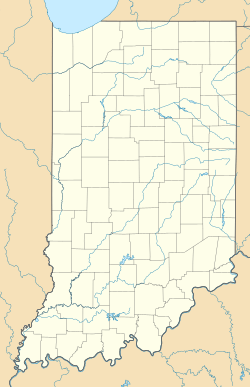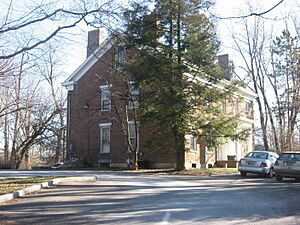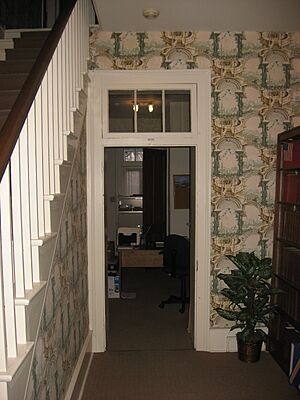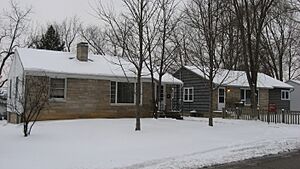Millen House facts for kids
Quick facts for kids |
|
|
Millen House
|
|
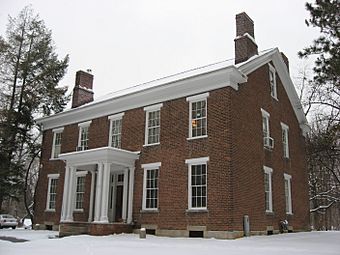
Front and eastern side of the house
|
|
| Location | 112 N. Bryan Ave., Bloomington, Indiana |
|---|---|
| Area | Less than 1 acre (0.40 ha) |
| Built | 1845 |
| Architectural style | Greek Revival |
| NRHP reference No. | 04001104 |
| Added to NRHP | September 29, 2004 |
The Millen House (also known as "Raintree House") is a very old home located on the campus of Indiana University in Bloomington, Indiana, United States. It was built by an early farmer and is one of Bloomington's oldest houses. Today, it is recognized as an important historic landmark.
Template:TOC limit=3
Contents
The Millen Family's New Home
William Moffett Millen was born in 1801 in South Carolina. He married Eleanor McGill, and they moved to Bloomington around 1833. Many people from South Carolina, like the Millens, moved north at this time. They were mostly Scotch-Irish and belonged to small Presbyterian churches.
These families moved because they did not agree with slavery, which was common in South Carolina. Many of their churches, like the Reformed Presbyterian Church, were strongly against slavery. They became abolitionists, meaning they worked to end slavery. When the economy in South Carolina became difficult in the 1820s, many of these families sold their farms and moved to free states like Indiana.
Starting a Farm in Bloomington
William Millen, an abolitionist, chose to move to Bloomington. The town was founded about fifteen years earlier and was home to the Indiana State Seminary. Even though it was far from major travel routes like the Ohio River, Bloomington was growing. It was becoming a center for education and the main town in Monroe County.
When the Millen family arrived, about 700 people lived in Bloomington. William bought a large piece of land, about 160 acres, between two main roads. He, his wife, and their three children built a log cabin there. They grew crops like corn, wheat, oats, and potatoes. They also had many animals, including 35 cattle, which was a lot for a small farm back then.
Besides farming, the Millens also made bricks using a kiln. They used these bricks to build many important buildings in the city. Over the years, their farm grew even bigger. By 1860, it was twice its original size, covering 320 acres.
Building the Millen House
As William Millen became more successful, he decided to build a much larger house in 1845. This new home replaced their log cabin. It was a big house built in the Georgian style, with features from Greek Revival designs. Most of the bricks used to build it came from his own kiln.
Building such a large house showed how well-off the Millens were. The first houses in Bloomington were much simpler. Styles like Georgian and Greek Revival showed that more fancy building ideas from the Eastern United States were becoming popular. The Millen House is a two-story building made of bricks pressed by hand. It sits on a limestone base, and its wooden frame is made from strong tuliptree wood. The inside walls are also made of brick and are very thick, from 8 to 12 inches (20 to 30 cm).
House Design and Details
The Millen House has a very balanced and orderly design. It is a rectangular building with 27 windows, all the same size. These windows are placed in a regular pattern around the entrances on the front and back of the house. There are also windows on the sides. The house has two chimneys on each end of the roof.
Inside, each floor is divided into four rooms with a central hallway. Every room has a fireplace and doors leading to the hallway and the next room. The house does not have many fancy decorations. The most noticeable features are the four Doric columns on the small front porch. There is also a simple decorative border, called a cornice, at the bottom of the porch roof. Many original parts of the house are still there, like the fireplaces, wooden details, window glass, and moldings. However, the fireplaces have been changed so they can no longer be used for fires.
The House's Journey Through Time
William Millen was part of the Associate Reformed Presbyterian Church, but he was also close with leaders of the Bloomington Reformed Presbyterian Church. These leaders were strong abolitionists and helped with the Underground Railroad. The Underground Railroad was a secret network that helped enslaved people escape to freedom. Since these leaders lived on farms near Millen's, it's possible he helped them. Local stories say the Millen House was a "station" on the Underground Railroad, meaning it was a safe place for people to hide. While there is no definite proof, it is certainly possible given the close ties.
New Owners and University Life
William Millen sold his house and farm to James Clark in 1880. After that, the property changed hands several times. In 1900, a family named Rogers sold the farm at an auction to Henry and Minnie Lee for less than $4,000. As Bloomington grew eastward, the land became more valuable.
In 1923, the Lees sold most of the farm for building new homes. They then sold the house itself for $7,500 to Agnes Wells, a professor at Indiana University. Professor Wells often rented the house to university students. In 1946, Indiana University bought the house. At that time, many soldiers were returning from war and going to college because of the G.I. Bill. The university needed more space, so they used the Millen House for faculty and staff. The area around it was bought for student housing.
The last private owner, Ann Stallknecht, bought the house in 1950. In 1969, she sold it back to the university, which has owned it ever since.
The Raintree House Today
Soon after the university bought the house again, a history professor named Thomas D. Clark helped move the headquarters of the Organization of American Historians into the Millen House in 1970. This organization is still there today. They often call it the "Raintree House" because of two large raintrees that used to grow on the property.
A Recognized Historic Place
The Millen House is one of the oldest and best-preserved homes in Monroe County. Only a few other Georgian-style houses from the early to mid-1800s still exist in the area. Most of them have been changed a lot, or are falling apart.
Between 1999 and 2001, experts looked at over two thousand buildings in Bloomington to see if they were historic. The Millen House was given an "Outstanding" rating. This is the highest rating and was given to less than three percent of the city's historic buildings. An "Outstanding" rating means a property is likely to be added to the National Register of Historic Places.
Because of its importance, more research was done on the house's history in the early 2000s. On September 29, 2004, the Millen House was officially listed on the National Register of Historic Places. It is one of about forty historic places in Monroe County with this special recognition.


